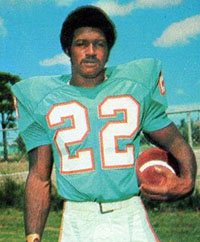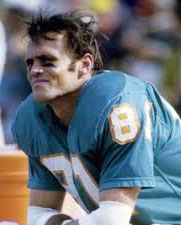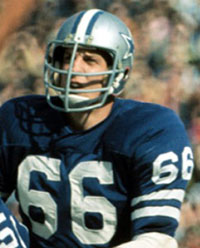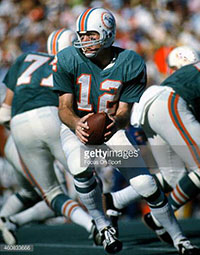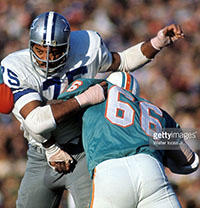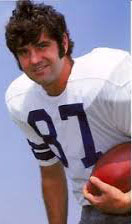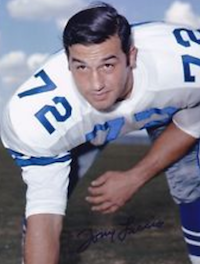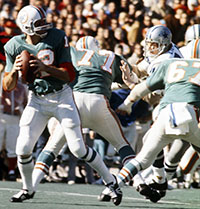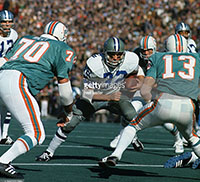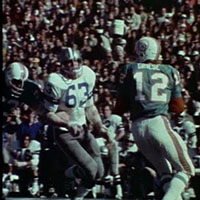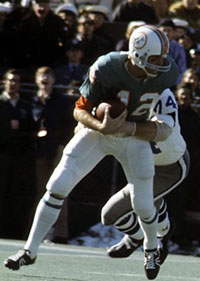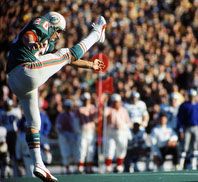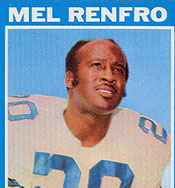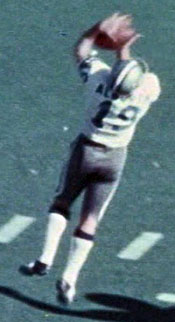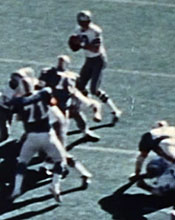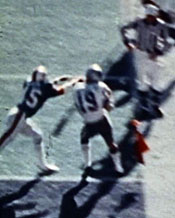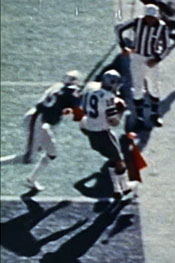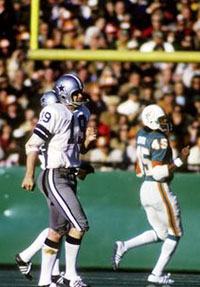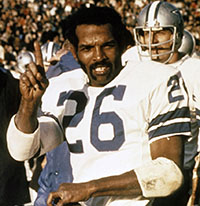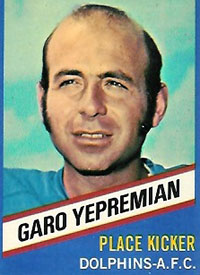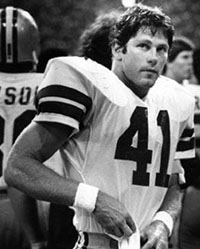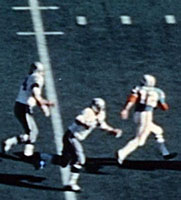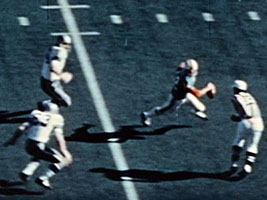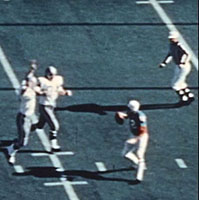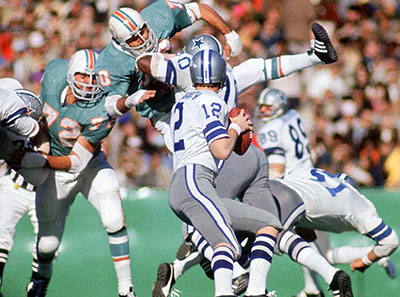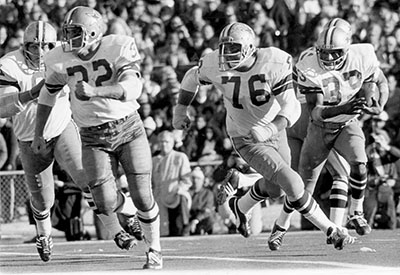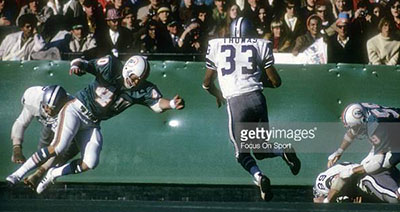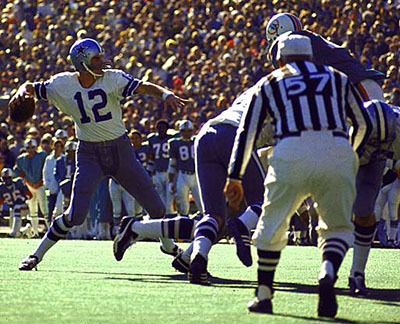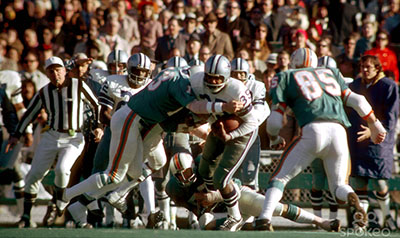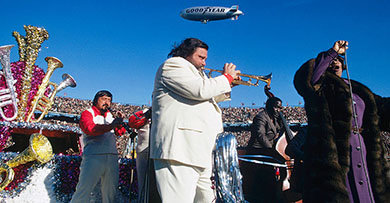Note: The gray boxes contain asides that provide interesting material but could be skipped
without losing the continuity of the article.
Part 1 - Pregame | Part 3 - 2nd Half
|
|
81,023 witnessed a game that ranks near or at the top of the list of most boring Super Bowls.
Quarter 1 The Dolphins won the toss and elected to receive. Dallas chose to defend the North goal, which put the strong wind, gusting to 25 mph, at their backs. It also meant that the Miami receivers would have to look back into a bright sun in the southwest sky. Mercury Morris took Mike Clark's kick at the six and returned to the 26.QB Bob Griese threw a quick pass to WR Howard Twilley slanting across from the right but backpedaling MLB LeRoy Jordan got his right hand up to deflect it incomplete. With WR Paul Warfield going in motion across the formation to the left, HB Jim Kiick took a handout and sped through a big hole at left tackle to the 33, DE George Andrie getting a piece of his ankle to trip him up. When Warfield went in motion, Dallas CB Cornell Green followed him across the field because Landry had assigned Green to shadow the great Miami receiver all day. Cornell was to bracket Warfield inside while Ray Renfro bracketed him outside.
On 3rd-and-three, Kiick tried to turn the corner around right end, but OLB Dave Edwards dumped him for no gain. So Larry Seiple, averaging a little over 40y per kick, punted to speedy Bob Hayes, who took the ball on the bounce at the 22, and his momentum carried him out of bounds on the 20.
The Cowboys coaches had discovered in their film study that the Dolphins tipped their hand before every snap. If the wide receiver was out wide, it was a passing play. If the wide receiver lined up 7y closer to the line in a better blocking position, a run was coming.
Walt Garrison started at fullback with Duane Thomas lined up behind him at tailback. QB Roger Staubach took the snap and threw quickly to the right flat to Hayes, who retreated to take the pass and ran forward to the 25. TE Billy Truax brought in the next play, which called for Thomas to dart through a big hole created by LT Tony Liscio's block on DE Bill Stanfill to the 34 for a first down.
 Duane Thomas runs behind Walt Garrison. Liscio was in his second stint with the Cowboys. He had started at left tackle from 1966 until midway through the 1970 season when Ralph Neely took his place. Tony was traded to San Diego during the following summer in the deal that brought Lance Alworth to Dallas. But when the Chargers sent him to Miami, Liscio decided to retire instead and returned to Big D and sold real estate. When Neely broke his leg in a dirt bike accident seven games into the '71 season, Landry called Liscio. Totally out of shape since his retirement, Tony got his wife's permission to give it a try. He hurt his shoulder the first time he hit a blocking dummy, then pulled a hamstring. When practice ended, everyone ran "gassers" except him. He went straight to the locker room and got in the whirlpool, which would soon be christened the USS Liscio. But the following Sunday, he was on the field.
Roger dropped back to pass but, finding no one open, held the ball too long and was sacked by DT Manny Fernandez at the 28. Again finding no receiver, Roger scrambled back to the 29. On the next snap, he saw WR Lance Alworth open at the left sideline but the ball, lofted over retreating LB Mike Kolen, sailed out of bounds. Ron Widby's punt took a Miami bounce and was downed at the Dolphin 42.
 Staubach runs out of the pocket. Csonka's 12y run would be the longest of the afternoon for the Dolphins.
Thomas took a pitch around left end, but S Jake Scott came up to stop him after a gain of only two. Staubach faked a handoff and retreated to throw a screen pass. But with the rushers in on him, he scrambled to the Miami 45 to make it 3rd-and-three.
Shula: Csonka's fumble early in the game was important at the time, but it wasn't his fault. Our execution wasn't good. Griese just didn't make a good handoff. Griese recalled: I still don't know what happened to this day. I stuck the ball in his stomach like I always do. It was cold. The ball was slick. But I don't know, it was one of those things we have done a thousand times and always connected. The magnitude of turnovers during the Super Bowl is amazing. If that had happened during the regular season, there'd be no memory of it. Jordan: The media had talked all week about how Csonka didn't fumble. When we caused that fumble, we felt like we could control them the rest of the game. Staubach: I recall it was the most excited I'd ever been before a game. ... Naturally I was pretty nervous for a game like that. ... What reflected my nervousness was that I ran a couple of times on pass plays. I didn't get anywhere with it, though. The Dolphins pretty well contained me running.
Thomas went in motion to the right, but Staubach again took off from the pocket to the 41 to move the chains. Garrison started the new series by taking a tight handoff for 8y. Then the dependable fullback burst to the 24 behind a good block by G Blaine Nye. On 1st-and-ten, the Dolphins again pressured Staubach, who stepped out of one tackle before Jim Riley and Bob Heinz sacked him for a loss of 13.
Staubach tries to avoid the sack. Landry's game plan targeted Buoniconti. On every play, the Cowboys wanted to knock him down or at least get in his way or confuse him with misdirection. The Dallas runners often started with the flow one way before cutting back.
After Garrison banged for two over the left side to bring up 3rd-and-goal from the two, Landry called a play designed to draw a linebacker and safety to either Thomas or Ditka. All Staubach had to do was throw to the guy who was not double-covered. On the snap, both defenders went to Thomas, but instead of throwing to wide-open Ditka, Roger tossed to Duane, who was stopped for no gain by SS Dick Anderson. So Dallas settled for three. Clark booted a 9y field goal to complete the 11-play, 50y drive. Cowboys 3 Dolphins 0 (1:23)
Staubach recalled that throwing to the wrong man from the two was the turning point in the game for him. In the Super Bowl the year before, in almost exactly the same situation, we had the same play called. Craig Morton was the quarterback, and he looked to the tight end too long before throwing to the halfback on a quick screen. The pass was knocked down. What happened against Miami was that I never looked at the tight end at all. I threw to Thomas, who was stopped for no gain, and we had to kick a field goal. And Mike Ditka, our tight end, was wide open! We got back to the bench, and Mike was shook up and mad. Everybody was saying you should have done this or that. Right there the frustration left me. I just said, "To heck with this," and settled down.
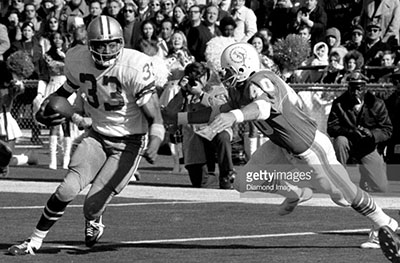 Dick Anderson stops Thomas for no gain. Shula thought he had cured Griese of his tendency to scramble but, in the heat of the moment, Bob reverted to his former ways. In his 1990 induction speech in Canton, he reminded everyone that the sack is the only Super Bowl record he still owned.
END OF Q1: Cowboys 3 Dolphins 0Lilly: We had a double stunt going on, between Larry Cole, Jethro Pugh, George Andrie, and myself. What happened was, when George came in, I was matched up with Bob Kuechenberg, and the center was usually waiting on me when I cam inside. George came in and pushed his tackle. I went straight ahead, then veered off George's tail, and Larry Cole did the same thing. We both had clean escapes. I could see him getting panicky, knowing he was so close to the end zone. He wanted to dump the ball, but he never had a chance. Kuechenberg later said: I'd have to say in my fifteen years in the NFL, Bob Lilly was the best defensive tackle I have ever seen. He is in a class by himself. Jethro Pugh: Griese was a scrambler, but he became a pocket passer under Shula. Coach Landry told us we need to make Griese go back to his old ways. Dolphins S Dick Anderson watched the play from the sideline. There are a lot of times that a play takes the wind out of your sails. That was one.
Quarter 2
The halftime show honored New Orleans native Louie Armstrong, who had died the previous summer. It featured Ella Fitzgerald, Carol Channing, and New Orleans' own Al Hirt along with the U.S. Marine Corps Drill Team.
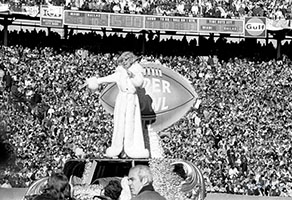 Carol Channing on a Mardi Gras-type float. |
